Zixu Wang
TRIDE: A Text-assisted Radar-Image weather-aware fusion network for Depth Estimation
Aug 11, 2025Abstract:Depth estimation, essential for autonomous driving, seeks to interpret the 3D environment surrounding vehicles. The development of radar sensors, known for their cost-efficiency and robustness, has spurred interest in radar-camera fusion-based solutions. However, existing algorithms fuse features from these modalities without accounting for weather conditions, despite radars being known to be more robust than cameras under adverse weather. Additionally, while Vision-Language models have seen rapid advancement, utilizing language descriptions alongside other modalities for depth estimation remains an open challenge. This paper first introduces a text-generation strategy along with feature extraction and fusion techniques that can assist monocular depth estimation pipelines, leading to improved accuracy across different algorithms on the KITTI dataset. Building on this, we propose TRIDE, a radar-camera fusion algorithm that enhances text feature extraction by incorporating radar point information. To address the impact of weather on sensor performance, we introduce a weather-aware fusion block that adaptively adjusts radar weighting based on current weather conditions. Our method, benchmarked on the nuScenes dataset, demonstrates performance gains over the state-of-the-art, achieving a 12.87% improvement in MAE and a 9.08% improvement in RMSE. Code: https://github.com/harborsarah/TRIDE
InfoNCE is a Free Lunch for Semantically guided Graph Contrastive Learning
May 07, 2025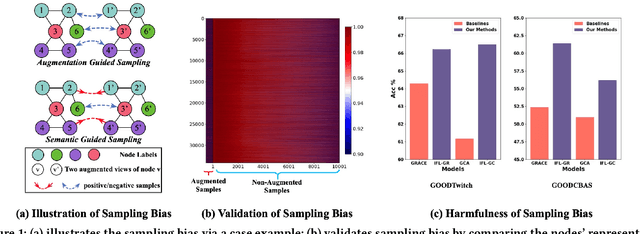
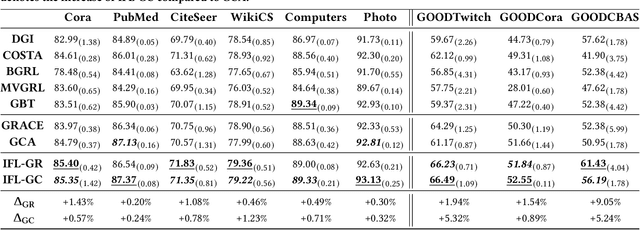
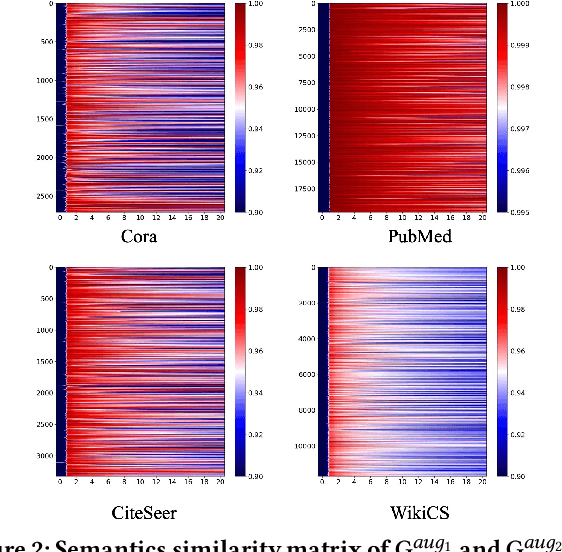

Abstract:As an important graph pre-training method, Graph Contrastive Learning (GCL) continues to play a crucial role in the ongoing surge of research on graph foundation models or LLM as enhancer for graphs. Traditional GCL optimizes InfoNCE by using augmentations to define self-supervised tasks, treating augmented pairs as positive samples and others as negative. However, this leads to semantically similar pairs being classified as negative, causing significant sampling bias and limiting performance. In this paper, we argue that GCL is essentially a Positive-Unlabeled (PU) learning problem, where the definition of self-supervised tasks should be semantically guided, i.e., augmented samples with similar semantics are considered positive, while others, with unknown semantics, are treated as unlabeled. From this perspective, the key lies in how to extract semantic information. To achieve this, we propose IFL-GCL, using InfoNCE as a "free lunch" to extract semantic information. Specifically, We first prove that under InfoNCE, the representation similarity of node pairs aligns with the probability that the corresponding contrastive sample is positive. Then we redefine the maximum likelihood objective based on the corrected samples, leading to a new InfoNCE loss function. Extensive experiments on both the graph pretraining framework and LLM as an enhancer show significantly improvements of IFL-GCL in both IID and OOD scenarios, achieving up to a 9.05% improvement, validating the effectiveness of semantically guided. Code for IFL-GCL is publicly available at: https://github.com/Camel-Prince/IFL-GCL.
Modality Decoupling is All You Need: A Simple Solution for Unsupervised Hyperspectral Image Fusion
Dec 06, 2024Abstract:Hyperspectral Image Fusion (HIF) aims to fuse low-resolution hyperspectral images (LR-HSIs) and high-resolution multispectral images (HR-MSIs) to reconstruct high spatial and high spectral resolution images. Current methods typically apply direct fusion from the two modalities without valid supervision, failing to fully perceive the deep modality-complementary information and hence, resulting in a superficial understanding of inter-modality connections. To bridge this gap, we propose a simple and effective solution for unsupervised HIF with an assumption that modality decoupling is essential for HIF. We introduce the modality clustering loss that ensures clear guidance of the modality, decoupling towards modality-shared features while steering clear of modality-complementary ones. Also, we propose an end-to-end Modality-Decoupled Spatial-Spectral Fusion (MossFuse) framework that decouples shared and complementary information across modalities and aggregates a concise representation of the LR-HSI and HR-MSI to reduce the modality redundancy. Systematic experiments over multiple datasets demonstrate that our simple and effective approach consistently outperforms the existing HIF methods while requiring considerably fewer parameters with reduced inference time.
SCIGS: 3D Gaussians Splatting from a Snapshot Compressive Image
Nov 19, 2024



Abstract:Snapshot Compressive Imaging (SCI) offers a possibility for capturing information in high-speed dynamic scenes, requiring efficient reconstruction method to recover scene information. Despite promising results, current deep learning-based and NeRF-based reconstruction methods face challenges: 1) deep learning-based reconstruction methods struggle to maintain 3D structural consistency within scenes, and 2) NeRF-based reconstruction methods still face limitations in handling dynamic scenes. To address these challenges, we propose SCIGS, a variant of 3DGS, and develop a primitive-level transformation network that utilizes camera pose stamps and Gaussian primitive coordinates as embedding vectors. This approach resolves the necessity of camera pose in vanilla 3DGS and enhances multi-view 3D structural consistency in dynamic scenes by utilizing transformed primitives. Additionally, a high-frequency filter is introduced to eliminate the artifacts generated during the transformation. The proposed SCIGS is the first to reconstruct a 3D explicit scene from a single compressed image, extending its application to dynamic 3D scenes. Experiments on both static and dynamic scenes demonstrate that SCIGS not only enhances SCI decoding but also outperforms current state-of-the-art methods in reconstructing dynamic 3D scenes from a single compressed image. The code will be made available upon publication.
Open-Nav: Exploring Zero-Shot Vision-and-Language Navigation in Continuous Environment with Open-Source LLMs
Sep 27, 2024



Abstract:Vision-and-Language Navigation (VLN) tasks require an agent to follow textual instructions to navigate through 3D environments. Traditional approaches use supervised learning methods, relying heavily on domain-specific datasets to train VLN models. Recent methods try to utilize closed-source large language models (LLMs) like GPT-4 to solve VLN tasks in zero-shot manners, but face challenges related to expensive token costs and potential data breaches in real-world applications. In this work, we introduce Open-Nav, a novel study that explores open-source LLMs for zero-shot VLN in the continuous environment. Open-Nav employs a spatial-temporal chain-of-thought (CoT) reasoning approach to break down tasks into instruction comprehension, progress estimation, and decision-making. It enhances scene perceptions with fine-grained object and spatial knowledge to improve LLM's reasoning in navigation. Our extensive experiments in both simulated and real-world environments demonstrate that Open-Nav achieves competitive performance compared to using closed-source LLMs.
GET-UP: GEomeTric-aware Depth Estimation with Radar Points UPsampling
Sep 02, 2024



Abstract:Depth estimation plays a pivotal role in autonomous driving, facilitating a comprehensive understanding of the vehicle's 3D surroundings. Radar, with its robustness to adverse weather conditions and capability to measure distances, has drawn significant interest for radar-camera depth estimation. However, existing algorithms process the inherently noisy and sparse radar data by projecting 3D points onto the image plane for pixel-level feature extraction, overlooking the valuable geometric information contained within the radar point cloud. To address this gap, we propose GET-UP, leveraging attention-enhanced Graph Neural Networks (GNN) to exchange and aggregate both 2D and 3D information from radar data. This approach effectively enriches the feature representation by incorporating spatial relationships compared to traditional methods that rely only on 2D feature extraction. Furthermore, we incorporate a point cloud upsampling task to densify the radar point cloud, rectify point positions, and derive additional 3D features under the guidance of lidar data. Finally, we fuse radar and camera features during the decoding phase for depth estimation. We benchmark our proposed GET-UP on the nuScenes dataset, achieving state-of-the-art performance with a 15.3% and 14.7% improvement in MAE and RMSE over the previously best-performing model.
TransMA: an explainable multi-modal deep learning model for predicting properties of ionizable lipid nanoparticles in mRNA delivery
Jul 08, 2024Abstract:As the primary mRNA delivery vehicles, ionizable lipid nanoparticles (LNPs) exhibit excellent safety, high transfection efficiency, and strong immune response induction. However, the screening process for LNPs is time-consuming and costly. To expedite the identification of high-transfection-efficiency mRNA drug delivery systems, we propose an explainable LNPs transfection efficiency prediction model, called TransMA. TransMA employs a multi-modal molecular structure fusion architecture, wherein the fine-grained atomic spatial relationship extractor named molecule 3D Transformer captures three-dimensional spatial features of the molecule, and the coarse-grained atomic sequence extractor named molecule Mamba captures one-dimensional molecular features. We design the mol-attention mechanism block, enabling it to align coarse and fine-grained atomic features and captures relationships between atomic spatial and sequential structures. TransMA achieves state-of-the-art performance in predicting transfection efficiency using the scaffold and cliff data splitting methods on the current largest LNPs dataset, including Hela and RAW cell lines. Moreover, we find that TransMA captures the relationship between subtle structural changes and significant transfection efficiency variations, providing valuable insights for LNPs design. Additionally, TransMA's predictions on external transfection efficiency data maintain a consistent order with actual transfection efficiencies, demonstrating its robust generalization capability. The code, model and data are made publicly available at https://github.com/wklix/TransMA/tree/master. We hope that high-accuracy transfection prediction models in the future can aid in LNPs design and initial screening, thereby assisting in accelerating the mRNA design process.
CoNav: A Benchmark for Human-Centered Collaborative Navigation
Jun 04, 2024Abstract:Human-robot collaboration, in which the robot intelligently assists the human with the upcoming task, is an appealing objective. To achieve this goal, the agent needs to be equipped with a fundamental collaborative navigation ability, where the agent should reason human intention by observing human activities and then navigate to the human's intended destination in advance of the human. However, this vital ability has not been well studied in previous literature. To fill this gap, we propose a collaborative navigation (CoNav) benchmark. Our CoNav tackles the critical challenge of constructing a 3D navigation environment with realistic and diverse human activities. To achieve this, we design a novel LLM-based humanoid animation generation framework, which is conditioned on both text descriptions and environmental context. The generated humanoid trajectory obeys the environmental context and can be easily integrated into popular simulators. We empirically find that the existing navigation methods struggle in CoNav task since they neglect the perception of human intention. To solve this problem, we propose an intention-aware agent for reasoning both long-term and short-term human intention. The agent predicts navigation action based on the predicted intention and panoramic observation. The emergent agent behavior including observing humans, avoiding human collision, and navigation reveals the efficiency of the proposed datasets and agents.
Negative as Positive: Enhancing Out-of-distribution Generalization for Graph Contrastive Learning
May 25, 2024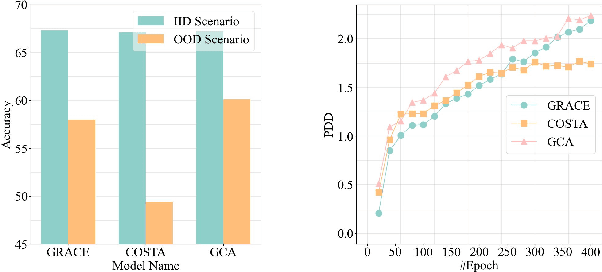
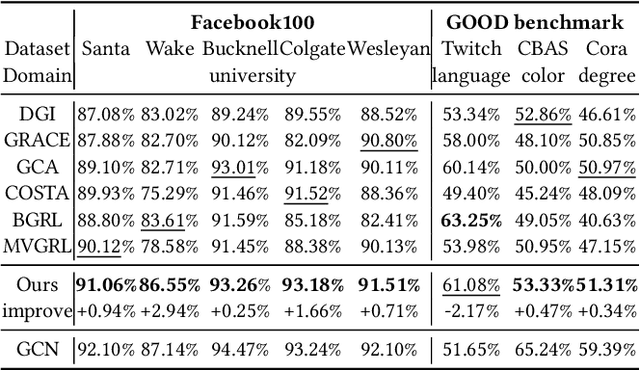
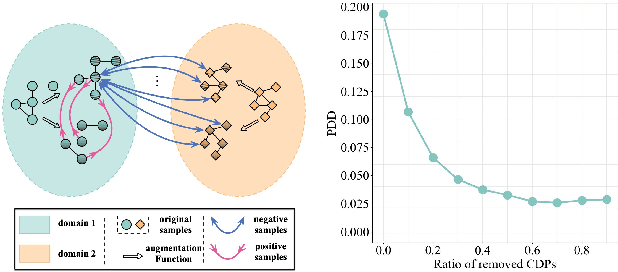

Abstract:Graph contrastive learning (GCL), standing as the dominant paradigm in the realm of graph pre-training, has yielded considerable progress. Nonetheless, its capacity for out-of-distribution (OOD) generalization has been relatively underexplored. In this work, we point out that the traditional optimization of InfoNCE in GCL restricts the cross-domain pairs only to be negative samples, which inevitably enlarges the distribution gap between different domains. This violates the requirement of domain invariance under OOD scenario and consequently impairs the model's OOD generalization performance. To address this issue, we propose a novel strategy "Negative as Positive", where the most semantically similar cross-domain negative pairs are treated as positive during GCL. Our experimental results, spanning a wide array of datasets, confirm that this method substantially improves the OOD generalization performance of GCL.
SocialFormer: Social Interaction Modeling with Edge-enhanced Heterogeneous Graph Transformers for Trajectory Prediction
May 06, 2024Abstract:Accurate trajectory prediction is crucial for ensuring safe and efficient autonomous driving. However, most existing methods overlook complex interactions between traffic participants that often govern their future trajectories. In this paper, we propose SocialFormer, an agent interaction-aware trajectory prediction method that leverages the semantic relationship between the target vehicle and surrounding vehicles by making use of the road topology. We also introduce an edge-enhanced heterogeneous graph transformer (EHGT) as the aggregator in a graph neural network (GNN) to encode the semantic and spatial agent interaction information. Additionally, we introduce a temporal encoder based on gated recurrent units (GRU) to model the temporal social behavior of agent movements. Finally, we present an information fusion framework that integrates agent encoding, lane encoding, and agent interaction encoding for a holistic representation of the traffic scene. We evaluate SocialFormer for the trajectory prediction task on the popular nuScenes benchmark and achieve state-of-the-art performance.
 Add to Chrome
Add to Chrome Add to Firefox
Add to Firefox Add to Edge
Add to Edge